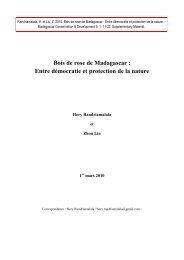Journal Madagascar Conservation - Madagascar Wildlife ...
Journal Madagascar Conservation - Madagascar Wildlife ...
Journal Madagascar Conservation - Madagascar Wildlife ...
You also want an ePaper? Increase the reach of your titles
YUMPU automatically turns print PDFs into web optimized ePapers that Google loves.
MADAGASCAR CONSERVATION & DEVELOPMENT VOLUME 3 | ISSUE 1 — DECEMBER 2008 PAGE 25<br />
FIGURE 2. Pteropus rufus snared using hook - like plant burrs whilst<br />
feeding on kapok trees near Kirindy - Mite National Park (Photo: R. A.<br />
Andrianaivoarivelo)<br />
flyways were cleared in the vegetation surrounding the cave<br />
entrance and the bats were swatted with a wooden whip - like<br />
baton as they emerged (Figure 5).<br />
Eidolon dupreanum and some molossids roost in fissures.<br />
E. dupreanum is a medium - sized megachiropteran (300 g) that<br />
is hunted for meat in many parts of <strong>Madagascar</strong> (Ranivo 2001,<br />
MacKinnon et al. 2003). Its roost sites are usually very high and<br />
located in cliffs and rock faces, making direct access by hunters<br />
difficult. Hunting is usually undertaken by specialists who either<br />
access roosts with wooden ladders or light fires directly under-<br />
neath the roosts and net or swat flying bats as they emerge<br />
(Table 1). Alternatively, a hunter is lowered on a rope and hits<br />
the bats with a stick as they emerge (Table 1).<br />
Only a few Malagasy bat species roost in foliage, notably<br />
Pteropus rufus, Myzopoda aurita and Hipposideros commer-<br />
soni. The latter species roosts singly in trees at some sites<br />
but is difficult to locate during the day and we know of only<br />
one area where the bats are taken from trees and eaten. In PN<br />
d’Ankarafantsika local people collect a forest tuber (Dioscorea<br />
maciba, Dioscoreaceae) and occasionally encounter roosting<br />
H. commersoni which are taken back to the village and eaten<br />
(Table 1). In the area around Tampolo forest, people collecting<br />
leaves of the Travellers’ palm (Ravenala madagascariensis<br />
Strelitziaceae) for housing materials often encounter M. aurita<br />
roosting in the unfurled leaves. Although there was no evidence<br />
that bats were deliberately sought, they were collected and<br />
taken back to the village where they were cooked and eaten. The<br />
<strong>Madagascar</strong> flying fox P. rufus is the island’s largest bat (ca. 600<br />
g) and roosts in the upper branches of large trees. It forms large<br />
(up to 5,000 individuals, MacKinnon et al. 2003), noisy colonies<br />
and is the main source of bat bushmeat in <strong>Madagascar</strong>. In many<br />
regions nets are erected inside or on the periphery (Figure 6)<br />
of roosts to intercept flying bats (Jenkins et al. 2007b). Firearms,<br />
notably shotguns, are also used to hunt P. rufus is many<br />
areas. In eastern <strong>Madagascar</strong> individual trees with roosting bats<br />
are felled by hunters who club the fallen animals with sticks<br />
(MacKinnon et al. 2003).<br />
BATS AS BUSHMEAT There are few eye - witness accounts<br />
from biologists on the seasonality and frequency of hunting<br />
or the destination of the bat meat, and most reports are based<br />
FIGURE 3. Hunting Rousettus madagascariensis on Nosy Boraha: one man in<br />
the cave disturbs the bats by throwing sticks and his fellow hunters wait at<br />
the cave entrance to strike emerging bats (Photo: F. H. Randrianandrianina).<br />
FIGURE 4. The results of a daily hunting trip to a cave roost of Rousettus<br />
madagascariensis on Nosy Boraha (Photo: F. H. Randrianandrianina).<br />
FIGURE 5. A hunter near Itampolo poised at the ‘mouth’ of a ride cut in the<br />
forest from the cave to channel the emerging Hipposideros commersoni<br />
towards his long stick (Photo: H. J. Razafimanahaka).



